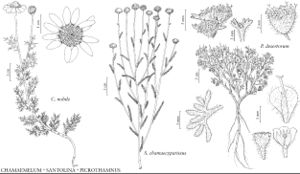Picrothamnus
Trans. Amer. Philos Soc., n. s. 7: 417. 1841.
| Taxon | Illustrator ⠉ | |
|---|---|---|
 | Chamaemelum nobile Santolina chamaecyparissus Picrothamnus desertorum | Yevonn Wilson-Ramsey Yevonn Wilson-Ramsey John Myers |
Subshrubs or shrubs, 5–30 (–50) cm (strongly aromatic). Stems 1–10+, usually erect, diffusely branched from bases and throughout (some laterals persistent, forming thorns), villous to arachnose (hairs medifixed). Leaves mostly cauline; alternate; petiolate or sessile; blades ± orbiculate to flabellate, simple or 1–2-pedately lobed (lobes orbiculate to spatulate or linear), ultimate margins entire, faces ± villous and gland-dotted. Heads disciform, usually (2–12+) in ± leafy, racemiform to spiciform arrays, rarely borne singly. Involucres ± obconic, 2–3 (–5) mm diam. Phyllaries persistent, 5–8 in ± 2 series, distinct, ± obovate, subequal, margins and apices (hyaline) narrowly scarious. Receptacles convex (glabrous), epaleate. Ray-florets 0 (peripheral pistillate florets 2–8; corollas pale-yellow, ± filiform, ± villous). Disc-florets 5–13 (–15), functionally staminate; corollas pale-yellow (± villous), tubes ± cylindric, throats campanulate, lobes 5, ± deltate. Cypselae (brown) obovoid to ellipsoid, ribs 0, faces ± villous and obscurely nerved (pericarps without myxogenic cells or resin sacs); pappi 0. x = 9.
Distribution
w North America
Discussion
Species 1.
Separation of Picrothamnus from Artemisia calls attention to differing views of generic circumscription within Anthemideae (see discussion under Artemisia). Distinguished by its spinescent branches and relatively large heads held among the leaves, Picrothamnus is among the more distinct of proposed segregates. The diffuse-porous woods (S. Carlquist 1966) correspond to the early spring-blooming phenology of the plants and provide an anatomic feature that helps to distinguish Picrothamnus from Artemisia.
Selected References
None.